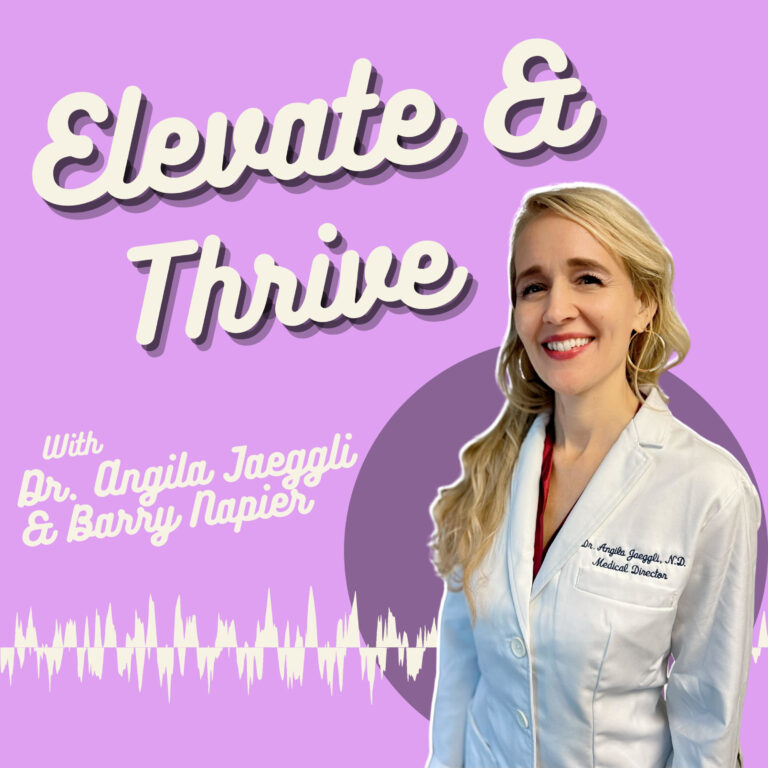
Your bi-monthly dose of health, healing, and happiness insights with Dr. Angila Jaeggli ND and Guests. Sharing the best in naturopathic medicine so you can live your best life.
🔥 Can You Unlock Your Full Potential? Jake Platt thinks so and he's developed a way to help you get there…
Have you ever felt like there's a healthier, stronger, more vibrant version of yourself just waiting to break free? 🤔
Guess what – it's not just wishful thinking; it's absolutely possible, and we've got the inside scoop!
In the latest episode of ”Elevate & Thrive,” we sat down with the phenomenal Jake Platt and got down to the nitty-gritty of transforming your life. 🎧 You're not going to want to miss this, trust me!
Here are just a few of the golden nuggets we unpacked:
1. 🛠️ The Morph Method – Your recipe for success starts with being mindful, organized, and sticking to routines that resonate with who you are. Jake's take on this is mind-blowing, and not your run-of-the-mill self-help fluff. It's real, actionable advice that's already changing lives.
2. 💧 H2Oh-So-Important – Hydration isn't just about drinking water; it's a foundation for health that's often overlooked. Jake dives deep into this topic and shows us why it's one of his six pillars. Drinking water will never feel the same again after you hear this!
3. 🔄 The Change Cycle – Change isn't a switch you flip; it's a journey with clear stages. From contemplation right through to maintaining those fab new habits, Jake walks us through how to navigate each step. It's like having a roadmap to your best self!
If you've been searching for that spark, that coach in your corner, or just some solid gold advice on how to elevate your game, take a listen. We made sure this chat was as relatable as it is revelatory.🌟
Why not take that first step toward your transformation today? I mean, what have you got to lose, except maybe a few bad habits and some self-doubt? 😉
Tune in, turn up the volume, and let's thrive together. And, as always, we'd love to hear your thoughts after the episode, so hit us up with your breakthroughs!
To magic and growth,
Dr. Angila 🌱
P.S. Don't forget, Jake’s offering a free 15-minute consultation – seize the opportunity!
#ElevateAndThrive #PersonalGrowth #FitnessJourney #HealthTransformation

Hey there, lovely readers!
Have you ever been in the middle of your morning routine, running a brush through your hair, only to find more strands tangled in the bristles than you’d like? If you’ve been noticing an unsettling increase in hair fall or thinning patches, first off—breathe. You’re not alone in this, and science has some fascinating insights (and solutions) to offer.
Why Does Hair Loss Happen Anyway?
Hair loss isn’t a one-size-fits-all situation. Both men and women can experience it, and the causes range from genetics to hormones, stress to certain medications, and even our diet. Surprising, right? Here’s a quick breakdown:
- Genetics: Ever heard of male-pattern or female-pattern baldness? Yep, it’s a family thing. If your parents or grandparents had hair loss, there’s a chance you might experience it too.
- Hormonal Changes: Pregnancy, childbirth, menopause, and thyroid issues can all cause hair loss.
- Medications: Some medicines for arthritis, cancer, heart problems, and even high blood pressure can result in hair thinning.
- Stress: Severe stress can cause sudden hair loss which could last several months.
- Diet: Not getting enough iron or protein? It might be showing in your hair.
Unpacking Hair Restoration
Now, let’s get into the exciting part: Hair Restoration! 🌱
The world of hair restoration has advanced leaps and bounds in recent years. It’s no longer just about transplants. Let’s explore two of the top methods:
- Topical Treatments: These are medicines you apply directly to the scalp. Minoxidil (you might know it as Rogaine) is one such popular treatment. It works by prolonging the growth phase of hair—meaning, it can delay hair from falling out too soon.
- PRP: Before we wrap up, there’s one more cutting-edge treatment in the world of hair restoration that deserves special mention: Platelet-Rich Plasma (PRP) Therapy.
- So, What’s PRP All About?
- Your blood is a fascinating concoction. Among other components, it contains plasma, and within that plasma are platelets. These platelets are rich in growth factors—molecules that play a pivotal role in healing.
- PRP therapy involves drawing a small amount of your blood, processing it to concentrate the platelets, and then injecting this concentrated PRP into your scalp. Sounds futuristic, doesn’t it?
- The Benefits of PRP for Hair Restoration
- Natural & Safe: Since PRP uses your blood, there’s little risk of allergic reactions or infections. It’s as natural as it gets!
- Stimulates Hair Growth: Those growth factors in PRP? They’re believed to stimulate dormant hair follicles and encourage them to enter the growth phase.
- Improves Hair Health: Many people report increased hair growth and healthier, thicker strands after undergoing PRP treatments.
- And the best part? PRP therapy is minimally invasive and requires little to no downtime. Plus, it pairs wonderfully with other treatments, offering a holistic approach to hair restoration.
- Taking the Next Step with PRP
- If PRP sounds like something you’d want to explore, you’re in luck. At Sage, we offer PRP hair restoration treatments tailored to individual needs. With trained professionals and a patient-centric approach, we’re committed to helping you reclaim not just your hair, but your confidence too.
- So, What’s PRP All About?
Lifestyle Considerations That Impact Your Hair
Okay, let’s chat lifestyle. The health of your hair isn’t just about what products you put on it. Here’s how you can give your locks some extra love:
- Dietary Choices: Your hair craves nutrients like iron, protein, and vitamins. Foods like spinach, eggs, and berries can be beneficial. And, don’t forget to hydrate! Water isn’t just great for your skin.
- Avoid Tight Hairstyles: Tight buns or ponytails can cause tension on your hair and pull them from the roots. Let your hair down—literally!
- Limit Heat Styling: We all love a good blowout, but frequent heat styling can weaken hair proteins, leading to breakage.
Time to Take Action!
Reading all this might have you wondering about your own hair health. Is what you’re experiencing normal? Should you be doing something differently?
Here’s a tip: If you’re concerned about your hair, it’s always a good idea to chat with a professional. They can offer guidance tailored just for you, from recommending specific treatments to suggesting lifestyle changes.
And guess what? At Sage, we’re here to help. Whether you want to explore restoration treatments or just chat about that sudden hair thinning after your last beach vacation—we’ve got you.
Remember: Every strand of your hair tells a story, from genetics to lifestyle choices. With the right information and care, you can ensure it’s a story of strength, health, and beauty.
Ready to embark on your hair rejuvenation journey? Feel that hair confidence again. Reach out to us at Sage and let’s chat. You deserve a crown of hair you can be proud of! 🌟👑
Did you find this post enlightening? Spread the word and share the science of hair with friends and family!
